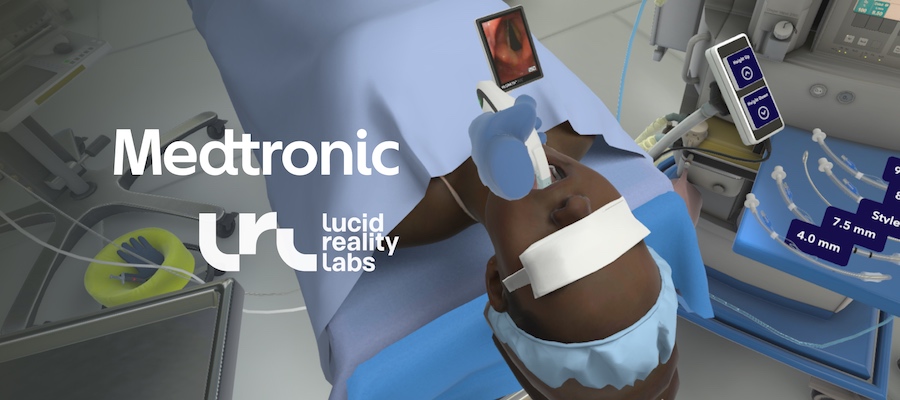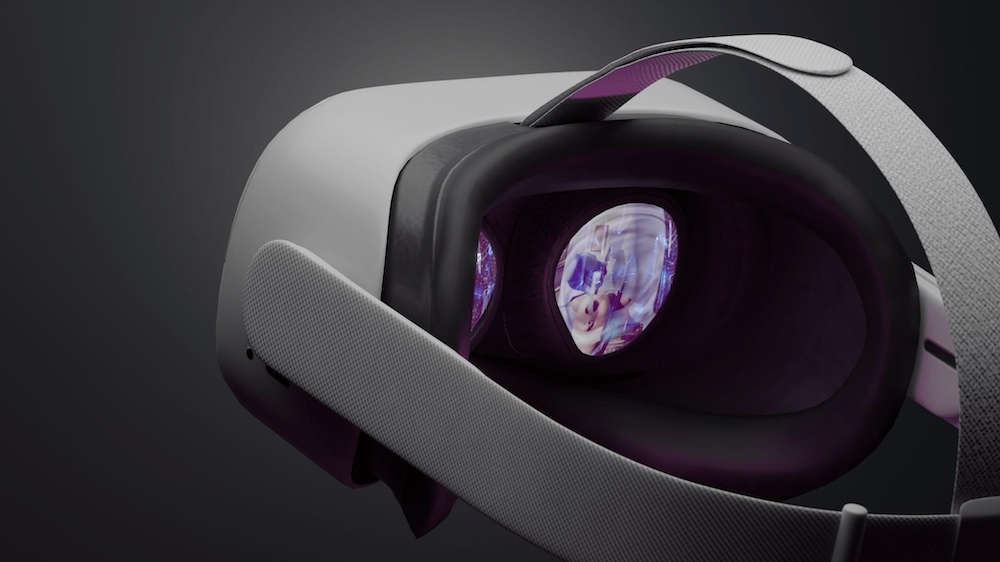Medtronic Provides Medical Device VR Training with Lucid Reality Labs
Technological innovation continues to be one of the paramount aspects of healthcare simulation that has helped accelerate the advancement of the entire industry, from medical device production, medical education, and training, to surgery, procedures, and even patient care. Healthcare simulation has also helped to uncover and showcase the best examples of innovation across medical education, including the latest immersive technology implementations using Virtual Reality (VR) and the benefits that can be delivered to medical specialists around the globe from this technology. This HealthySimulation.com article explains how a virtual reality healthcare simulation, offered via a medical VR intubation simulation experience developed by Lucid Reality Labs and Medtronic, can help leverage VR intubation processes.
In order to get a better grasp of VR technology incorporation, this article features expert insights from Medtronic, the global healthcare technology leader, amongst the first medical device companies to integrate VR as part of their educational offering. As well as Lucid Reality Labs, the prominent VR technology expert that has developed over 100 VR solutions, including solutions for healthcare, which were highly recognized by healthcare specialists, practitioners, institutions, associations, and companies around the globe for the technology’s ability to reduce required training time and costs, logistic expenses, improved outcomes, impacting related knowledge, self-efficacy, intention, and attitude in medical training, education and upskilling.
Today, hands-on training is as important as ever, yet when compared to classical clinical simulators, VR has critical advantages. These advantages include a higher level of immersion and realism, remote collaboration and mentorship, advanced gamification, and close to real-life hands-on training opportunities. Moreover, unlike standard healthcare simulations, VR allows educators to create a sense of pressure for learners, submerging them into a completely recreated virtual environment of an OR, emergency care, trauma center, or any diagnostics’ or treatment facility.
Sponsored Content:
This outcome can be made possible using digital twin technology, which implies the creation of 1-to-1 high-fidelity digital replicas of practically any device, function, procedure, patient scenario, and environment. Ultimately, VR can serve as the next-generation training tool for medical specialists looking to improve a variety of skills, including learning new procedures and tools, practicing setting up and using medical equipment and devices, preoperative planning, or even emergency preparedness in a risk-free, specialist-guided environment. At the same time, virtual reality allows turning the learning and proficiency curve to become more efficient.
Based on current projections, the global VR healthcare market size is estimated to reach 6.2 billion USD by 2029, as the technology is already being used to diagnose, plan and treat a wide spectrum of conditions while being incorporated into daily operations. At the same time, the global pandemic pushed many healthcare institutions to seek alternative ways of collaboration, interaction, training, and education. This led them to turn to virtual reality in healthcare simulations to connect and continue training and educating medical specialists.
Without a doubt, COVID-19 impacted and brought unique challenges to the field of medical training and education. This included the need to be flexible and prompt in delivering training, follow the WHO recommendations for infection control and safety as well as factor in cost and logistics restraints. At the same time, virtual reality offered viable alternatives that include full high-fidelity immersion, and hand- and eye-tracking enhanced experiences that allowed medical specialists to feel as if they were physically present and achieve a sense of accomplishment within each virtual experience.
Sponsored Content:
One such VR experience, already launched back in 2018, is the medical VR intubation simulation, a VR experience Lucid Reality Labs developed with Medtronic. This is an interactive and immersive VR intubation simulation experience created to demonstrate the product and train physicians and medical trainees on applying the correct intubation process. The solution presents the usage of the McGRATH™ MAC video laryngoscope as the standard of care by educating participants on how to perform an intubation procedure with a variety of patients and the complexity of intubation scenarios.
This immersive medical simulation provides a great opportunity for medical specialists and learners to enhance their skills and get new experiences in a realistic way. The solution provides an opportunity to train remotely and safely with maximum impact as well. Overall, the McGRATH™ MAC VR intubation simulation submerges users into a 3-dimensional operating room (OR) including equipment and sounds. The VR experience, therefore, blurs the boundaries of the tactile barrier allowing users of any age to fully immerse into the experience within two minutes. This is accomplished as one “steps into the OR to experience” being in the OR and having the exact sensation of a real intubation process.
The interactive VR intubation simulation demonstrates the capabilities of the McGRATH™ MAC video laryngoscope and enables physicians and medical trainees to practice an intubation procedure for five different patient scenarios, varying in complexity. Physicians must choose the correct McGRATH™ MAC video laryngoscopy blade as well as endotracheal tube from the range of options available, basing their decision on the selected patient profile. Then, they perform the intubation while the total intubation time, the number of vocal cords touched as well as broken teeth are being tracked.
Medtronic utilizes the power of VR to showcase the McGRATH™ MAC video laryngoscope, a handheld intubation device optimizing first-attempt success during both routine and difficult intubations. To date, the immersive simulation solution has been featured at over 50 healthcare conferences and medical trade shows around the globe. Including the European Society of Anaesthesiology and Intensive Care (ESAIC) 2019 & 2022 annual meetings in Vienna and Milan, the American Society of Anesthesiologists (ASA) ANESTHESIOLOGY 2021 in San Diego as well as the Critical Care and Perioperative Medicine (SFAR) 2021 annual congress in Paris.
“With our products we aim to engineer the extraordinary, striving to create groundbreaking technological solutions while optimizing healthcare systems around the globe. We see the incorporation of immersive technology as one of the next big steps in healthcare digitalization that could be used to enhance medical device demonstration and use training, and thus the ease and effectiveness of new medical tools and device integration for practitioners worldwide. Not only have we received excellent feedback from industry professionals on the educational value of this experience, we’ve also seen a positive contribution to the usage of video laryngoscopy as standard of care,” said Moniek Haan, Sr. Digital Marketing Manager at Medtronic.
Specialists of all levels, knowledge, and age groups were able to interact with the VR experience, choosing to submerge after or before they explored the actual physically available McGRATH™ MAC video laryngoscope. The VR experience received excellent feedback, with participants pointing out that the experience is a great education and training tool that allowed them to follow the correct steps, helping motorically remember the correct device usage and sequence as well as optimize and increase the speed of the procedure. The immersion allowed participants to experience the intubation process from the very beginning till the very end, live through the entire patient scenario, and react to certain intubation challenges and patient needs.
“Today, we use the Digital Twin technology to recreate or mimic practically any medical procedure or device for training and education purposes. The advancement in visual fidelity of VR headsets allows for more complex experiences that feel real, even though they are created virtually,” said Alex Dzyba, Lucid Reality Labs CEO. “As the virtual reality capabilities advance further, the integration will go far beyond current use cases, allowing to improve the healthcare system capabilities, training methods, and efficiency as well as patient outcomes for millions worldwide.”
That said, VR training can prove essential in practices requiring a particularly high level of skill and precision. A study conducted by the Department of Anesthesiology of the University Hospital of Lausanne in Switzerland in 2020 assessed the impact of this innovative medical VR intubation simulation on the improvement of airways management using the McGRATH™ MAC video laryngoscope.
A total of 437 participants (practicing anesthesiologists, department chairs, residents, nurses, and airway fellows) from 18 countries enrolled in this study. Amongst other results, it revealed that this VR simulation experience was identified as useful for teaching by 273 participants (71%), and 248 (65%) had an interest in acquiring this simulator for in-hospital educational purposes.
Such promising results open doors for further research which can deepen the understanding and assessment of the degree of influence that VR learning can bring to the performance of healthcare professionals in post-training, real-life situations.
“The developed VR simulator was brought to over 50 medical conferences around the globe, with over 6000 participants engaging with this immersive experience and majority finding it to be an excellent tool to try out the Medtronic McGRATH™ MAC Video laryngoscope in action. It gives participants an opportunity to perform the procedure in a safe environment as well as experiencing a sense of accomplishment. The VR simulator has served as a beneficial tool for medical professionals thus has increased the general product awareness and its benefits for the patients providing valuable data and enhancing the user experience,” said Dzyuba.
There is no doubt that educators and learners are on the doorstep of a new era in healthcare simulations, which will be more realistic, immersive, and efficient. This will likely be accelerated by virtual reality and the capabilities and benefits that will be delivered to millions of healthcare professionals and practitioners around the globe.
More About McGRATH™ MAC Video Laryngoscope
Video laryngoscopy is used in the operating room to visualize the vocal cords and related airway structures without a direct line of sight. It is a relatively new technology developed to improve the first-attempt success rate of airway (tracheal) intubation. Research has also shown that video laryngoscopy can help prevent clinician exposure to droplet-borne pathogens and further improve your safety.1 Recent guidelines recommend that airway management clinicians take precautions to further protect against droplet-borne pathogens.1 Routine use of the McGRATH™ MAC video laryngoscope (VL) improves first-attempt success rate2 and lessens hemodynamic response3,4 while improving economic benefits,5,6 when compared to the traditional direct visualization (DL) technique.
About Medtronic
Medtronic, the global healthcare technology leader, innovates medical products and services that transform two patient lives per second. With their groundbreaking healthcare technology solutions for even some of the most complex and challenging conditions, they are pushing forward to be the leader in healthcare technology by putting people at the center.
More About Lucid Reality Labs
Lucid Reality Labs is the World’s leading Immersive Technology consulting, design and development company with the primary focus on creating immersive XR training & simulations for Healthcare, MedTech, Pharma, Aerospace & Defense. Lucid Reality Labs is a team of diversely skilled professionals that develop the World’s first, unique, immersive, groundbreaking technological solutions for Fortune 500 clients around the globe.
Learn More About Medical VR Intubation Simulation
1. Cook TM, El-Boghdadly K, McGuire B, McNarry AF, Patel A, Higgs A. Consensus guidelines for managing the airway in patients with COVID-19: Guidelines from the Difficult Airway Society, the Association of Anaesthetists the Intensive Care Society, the Faculty of Intensive Care Medicine and the Royal College of Anaesthetists. Anaesthesia. 2020;75(6):785–799.
2. Kriege et al. Evaluation of the McGRATH™ MAC and Macintosh laryngoscope for tracheal intubation. Br J Anaesth. 2020; 125(1): e209
3. Altun D, Ali A, Çamcı E, Özonur A, Seyhan TÖ. Haemodynamic Response to Four Different Laryngoscopes. Turk J Anaesthesiol Reanim. 2018;46(6):434-440
4. Yokose M, Mihara T, Kuwahara S, Goto T. Effect of the McGRATH™ MAC Video Laryngoscope on Hemodynamic Response during Tracheal Intubation: A Retrospective Study. PLoS One. 2016;11(5):e0155566
5. Moucharite MA, Zhang J, Giffin R. Factors and Economic Outcomes Associated with Documented Difficult Intubation in the United States. Clinicoecon Outcomes Res. 2021;13:227–239
6. Zhang J, Jiang W, Urdaneta F. Economic analysis of the use of video laryngoscopy versus direct laryngoscopy in the surgical setting. J Comp Eff Res. Jul2021;10(10):831-844
Lance Baily, BA, EMT-B, is the Founder / CEO of HealthySimulation.com, which he started in 2010 while serving as the Director of the Nevada System of Higher Education’s Clinical Simulation Center of Las Vegas. Lance also founded SimGHOSTS.org, the world’s only non-profit organization dedicated to supporting professionals operating healthcare simulation technologies. His co-edited Book: “Comprehensive Healthcare Simulation: Operations, Technology, and Innovative Practice” is cited as a key source for professional certification in the industry. Lance’s background also includes serving as a Simulation Technology Specialist for the LA Community College District, EMS fire fighting, Hollywood movie production, rescue diving, and global travel. He and his wife live with their two brilliant daughters and one crazy dachshund in Las Vegas, Nevada.
Sponsored Content:



















